

Compact Muon Solenoid
LHC, CERN
| CMS-HIN-16-001 ; CERN-EP-2017-186 | ||
| Nuclear modification factor of $\mathrm{D}^0$ mesons in PbPb collisions at ${\sqrt{{s_{_{\mathrm{NN}}}}}} = $ 5.02 TeV | ||
| CMS Collaboration | ||
| 16 August 2017 | ||
| Phys. Lett. B 782 (2018) 474 | ||
| Abstract: The transverse momentum ($ p_{\mathrm{T}} $) spectrum of prompt $ \mathrm{D}^0 $ mesons and their antiparticles has been measured via the hadronic decay channels $ \mathrm{D}^0\to \mathrm{K}^{-} \pi^{+}$ and ${\overline{\mathrm{D}}}{}^0 \to \mathrm{K}^{+} \pi^{-}$ in pp and PbPb collisions at a centre-of-mass energy of 5.02 TeV per nucleon pair with the CMS detector at the LHC. The measurement is performed in the $ \mathrm{D}^0 $ meson $ p_{\mathrm{T}} $ range of 2-100 GeV/$c$ and in the rapidity range of $| y | < $ 1. The pp (PbPb) dataset used for this analysis corresponds to an integrated luminosity of 27.4 pb$^{-1}$ (530 $\mu$b$^{-1}$). The measured $ \mathrm{D}^0 $ meson $ p_{\mathrm{T}} $ spectrum in pp collisions is well described by perturbative QCD calculations. The nuclear modification factor, comparing $ \mathrm{D}^0 $ meson yields in PbPb and pp collisions, was extracted for both minimum-bias and the 10% most central PbPb interactions. For central events, the $ \mathrm{D}^0 $ meson yield in the PbPb collisions is suppressed by a factor of 5-6 compared to the pp reference in the $ p_{\mathrm{T}} $ range of 6-10 GeV/$c$. For $ \mathrm{D}^0 $ mesons in the high-$ p_{\mathrm{T}} $ range of 60-100 GeV/$c$, a significantly smaller suppression is observed. The results are also compared to theoretical calculations. | ||
| Links: e-print arXiv:1708.04962 [nucl-ex] (PDF) ; CDS record ; inSPIRE record ; HepData record ; CADI line (restricted) ; | ||
| Figures | Summary | Additional Figures | References | CMS Publications |
|---|
| Figures | |

png pdf |
Figure 1:
Examples of $ \mathrm{D}^0 $ candidate invariant mass distributions in pp (top) and PbPb (bottom) collisions at 5.02 TeV. |
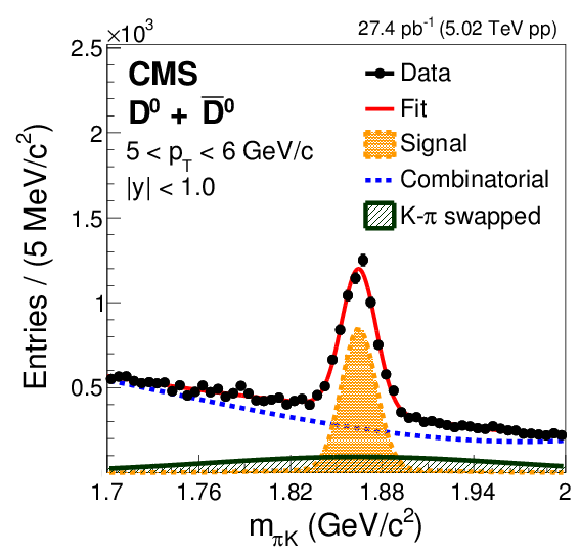
png pdf |
Figure 1-a:
Example of $ \mathrm{D}^0 $ candidate invariant mass distribution in pp collisions at 5.02 TeV. |

png pdf |
Figure 1-b:
Example of $ \mathrm{D}^0 $ candidate invariant mass distribution in pp collisions at 5.02 TeV. |
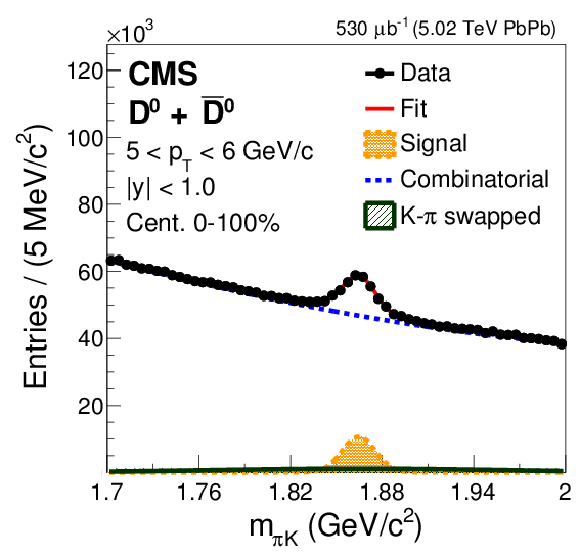
png pdf |
Figure 1-c:
Example of $ \mathrm{D}^0 $ candidate invariant mass distribution in PbPb collisions at 5.02 TeV. |
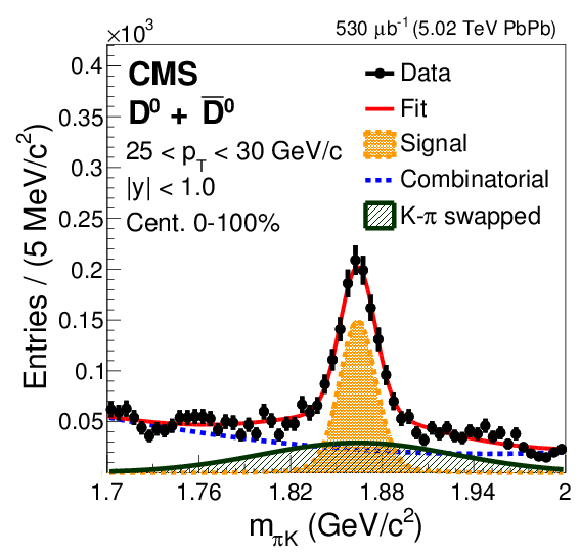
png pdf |
Figure 1-d:
Example of $ \mathrm{D}^0 $ candidate invariant mass distribution in PbPb collisions at 5.02 TeV. |
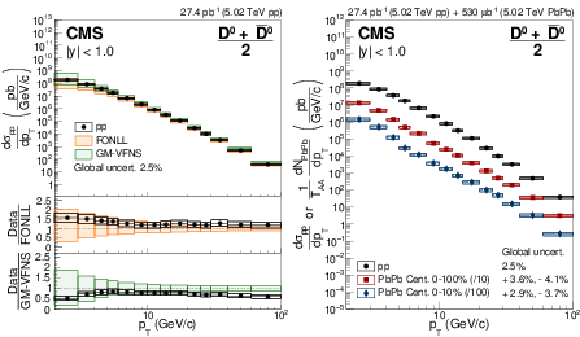
png pdf |
Figure 2:
(left) The $ {p_{\mathrm {T}}} $-differential production cross section of $\mathrm{D}^0 $ mesons in pp collisions at $ {\sqrt {s}} = $ 5.02 TeV. The vertical bars (boxes) correspond to statistical (systematic) uncertainties. The global systematic uncertainty, listed in the legend and not included in the point-to-point uncertainties, comprises the uncertainties in the integrated luminosity measurement and the $ \mathrm{D}^0 $ meson $\mathcal {B}$. Results are compared to FONLL [31] and GM-VFNS [33,34,35] calculations. (right) The $ {p_{\mathrm {T}}} $ -differential production yields of $ \mathrm{D}^0 $ mesons divided by the nuclear overlap functions $ {T_{\mathrm {AA}}} $ for PbPb collisions in the 0-100% (red) and 0-10% (blue) centrality ranges compared to the same pp cross sections shown in the left panel (black). |
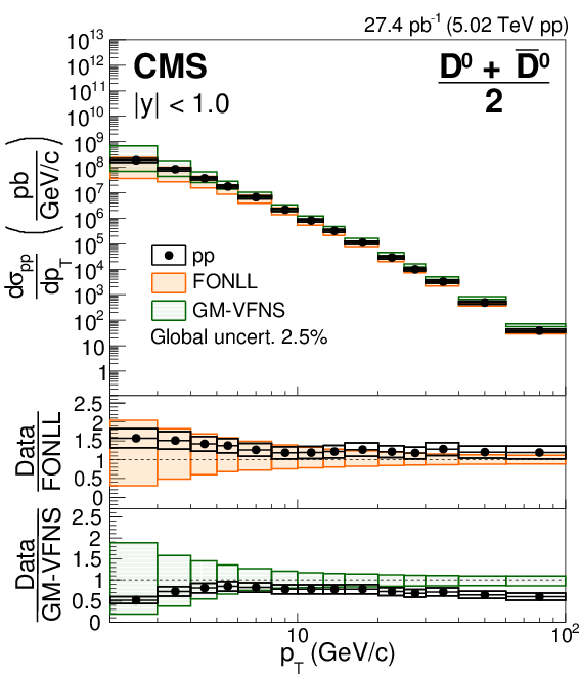
png pdf |
Figure 2-a:
The $ {p_{\mathrm {T}}} $-differential production cross section of $\mathrm{D}^0 $ mesons in pp collisions at $ {\sqrt {s}} = $ 5.02 TeV. The vertical bars (boxes) correspond to statistical (systematic) uncertainties. The global systematic uncertainty, listed in the legend and not included in the point-to-point uncertainties, comprises the uncertainties in the integrated luminosity measurement and the $ \mathrm{D}^0 $ meson $\mathcal {B}$. Results are compared to FONLL [31] and GM-VFNS [33,34,35] calculations. |
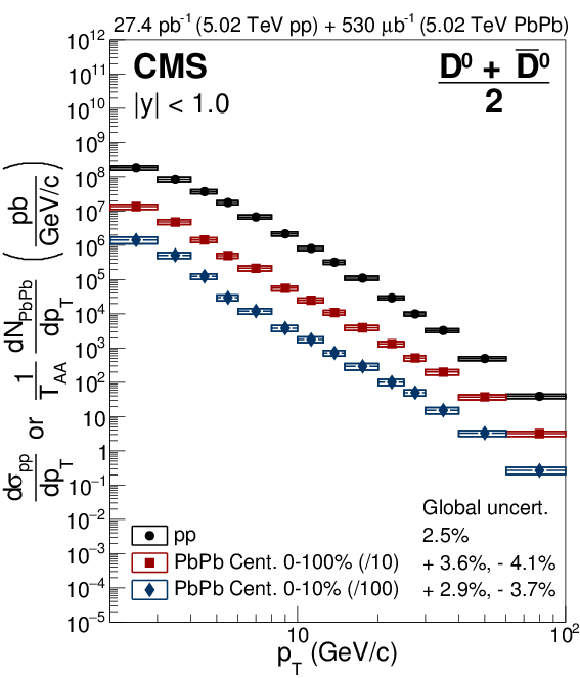
png pdf |
Figure 2-b:
The $ {p_{\mathrm {T}}} $ -differential production yields of $ \mathrm{D}^0 $ mesons divided by the nuclear overlap functions $ {T_{\mathrm {AA}}} $ for PbPb collisions in the 0-100% (red) and 0-10% (blue) centrality ranges compared to the same pp cross sections shown in the left panel (black). |
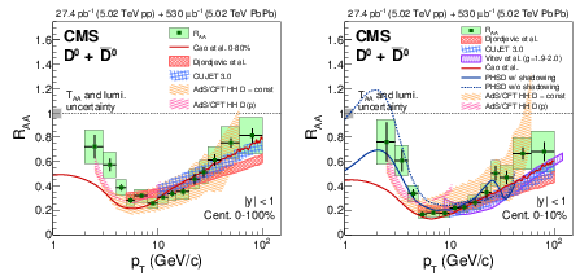
png pdf |
Figure 3:
$ {R_{\mathrm {AA}}} $ as a function of $ {p_{\mathrm {T}}} $ in the centrality range 0-100% (left) and 0-10% (right). The vertical bars (boxes) correspond to statistical (systematic) uncertainties. The global systematic uncertainty, represented as a grey box at $ {R_{\mathrm {AA}}} =$ 1, comprises the uncertainties in the integrated luminosity measurement and $ {T_{\mathrm {AA}}} $ value. The $ \mathrm{D}^0 $ $ {R_{\mathrm {AA}}} $ values are also compared to calculations from various theoretical models [36,37,38,39,40,41,42,43,44,45,46]. |
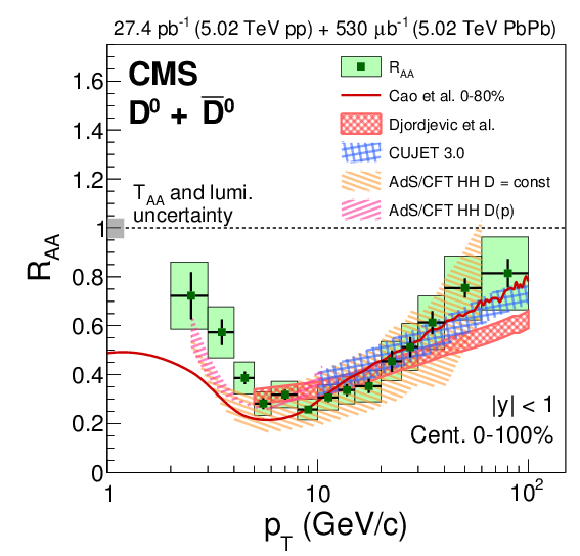
png pdf |
Figure 3-a:
$ {R_{\mathrm {AA}}} $ as a function of $ {p_{\mathrm {T}}} $ in the centrality range 0-100%. The vertical bars (boxes) correspond to statistical (systematic) uncertainties. The global systematic uncertainty, represented as a grey box at $ {R_{\mathrm {AA}}} =$ 1, comprises the uncertainties in the integrated luminosity measurement and $ {T_{\mathrm {AA}}} $ value. The $ \mathrm{D}^0 $ $ {R_{\mathrm {AA}}} $ values are also compared to calculations from various theoretical models [36,37,38,39,40,41,42,43,44,45,46]. |
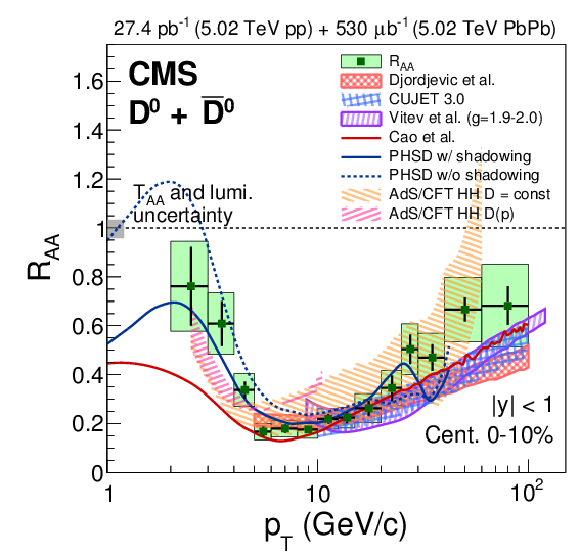
png pdf |
Figure 3-b:
$ {R_{\mathrm {AA}}} $ as a function of $ {p_{\mathrm {T}}} $ in the centrality range 0-10%. The vertical bars (boxes) correspond to statistical (systematic) uncertainties. The global systematic uncertainty, represented as a grey box at $ {R_{\mathrm {AA}}} =$ 1, comprises the uncertainties in the integrated luminosity measurement and $ {T_{\mathrm {AA}}} $ value. The $ \mathrm{D}^0 $ $ {R_{\mathrm {AA}}} $ values are also compared to calculations from various theoretical models [36,37,38,39,40,41,42,43,44,45,46]. |

png pdf |
Figure 4:
(left) Nuclear modification factor $ {R_{\mathrm {AA}}} $ as a function of $ {p_{\mathrm {T}}} $ in the centrality range 0-100% (green squares) compared to the $ {R_{\mathrm {AA}}} $ of charged particles (red circles) [21], ${\mathrm {B}^{\pm }}$ mesons (blue triangles) [47] at 5.02 TeV and to the $ {R_{\mathrm {AA}}} $ of nonprompt $ \mathrm{J}/\psi $ meson (purple crosses and stars) at 2.76 TeV [14] in the same centrality range. (right) Nuclear modification factor $ {R_{\mathrm {AA}}} $ as a function of $ {p_{\mathrm {T}}} $ in the centrality range 0-10% (green squares) compared to the $ {R_{\mathrm {AA}}} $ of charged particles (red circles) [21] in the same centrality range. |

png pdf |
Figure 4-a:
Nuclear modification factor $ {R_{\mathrm {AA}}} $ as a function of $ {p_{\mathrm {T}}} $ in the centrality range 0-100% (green squares) compared to the $ {R_{\mathrm {AA}}} $ of charged particles (red circles) [21], ${\mathrm {B}^{\pm }}$ mesons (blue triangles) [47] at 5.02 TeV and to the $ {R_{\mathrm {AA}}} $ of nonprompt $ \mathrm{J}/\psi $ meson (purple crosses and stars) at 2.76 TeV [14] in the same centrality range. |
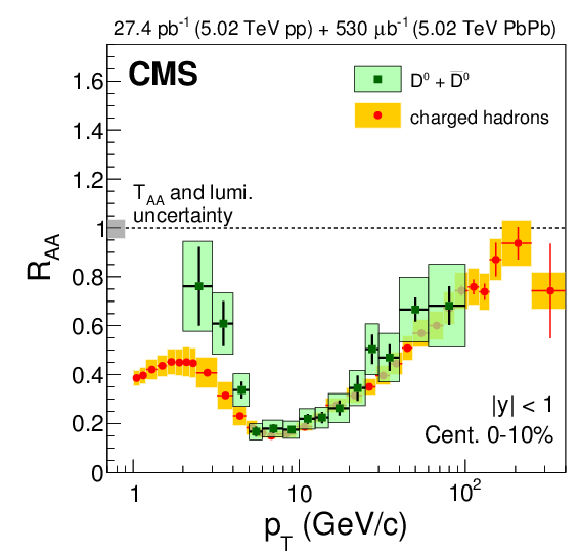
png pdf |
Figure 4-b:
Nuclear modification factor $ {R_{\mathrm {AA}}} $ as a function of $ {p_{\mathrm {T}}} $ in the centrality range 0-10% (green squares) compared to the $ {R_{\mathrm {AA}}} $ of charged particles (red circles) [21] in the same centrality range. |
| Summary |
| In this Letter, the transverse momentum ($ p_{\mathrm{T}} $) spectra of prompt $ \mathrm{D}^0 $ mesons in pp and PbPb collisions and the $ \mathrm{D}^0 $ meson nuclear modification factor ($ {R_{\mathrm{AA}}} $) in the central rapidity region ($| y | < $ 1) at ${\sqrt{{s_{_{\text{NN}}}}}} = $ 5.02 TeV from CMS are presented. The $ {R_{\mathrm{AA}}} $ of prompt $ \mathrm{D}^0 $ mesons is measured as a function of their $ p_{\mathrm{T}} $ from 2 to 100 GeV/$c$ in two centrality ranges, inclusive and 10% most central. The $ \mathrm{D}^0 $ meson yield is found to be strongly suppressed in PbPb collisions when compared to the measured pp reference data scaled by the number of binary nucleon-nucleon collisions. These measurements are consistent with the $ {R_{\mathrm{AA}}} $ of charged hadrons in both centrality intervals for $p_{\mathrm{T}} > $ 4 GeV/$c$. A hint of a smaller suppression of $ \mathrm{D}^0 $ $ {R_{\mathrm{AA}}} $ with respect to charged particle $ {R_{\mathrm{AA}}} $ is observed for $p_{\mathrm{T}} < $ 4 GeV/$c$. The $ \mathrm{D}^0 $ $ {R_{\mathrm{AA}}} $ was found to be compatible with the ${\mathrm{B}^{\pm}} $ $ {R_{\mathrm{AA}}} $ in the intermediate $ p_{\mathrm{T}} $ region and significantly lower than the nonprompt $ \mathrm{J}/\psi $ meson $ {R_{\mathrm{AA}}} $ at ${\sqrt{{s_{_{\text{NN}}}}}} = $ 2.76 TeV for $p_{\mathrm{T}}< $ 10 GeV/$c$. Comparisons to different theoretical models show that the general trend of the $ {R_{\mathrm{AA}}} $ is qualitatively reproduced at high $ p_{\mathrm{T}} $. Comparisons to different theoretical models show that the general trend of the $ {R_{\mathrm{AA}}} $ is qualitatively reproduced at high $ p_{\mathrm{T}} $, while quantitative agreement for all centrality and $ p_{\mathrm{T}} $ selections is yet to be attained. |
| Additional Figures | |

png pdf |
Additional Figure 1:
Fraction of $ {\mathrm {D}^{0}} $ mesons that come directly from c quark fragmentation as a function of $p_{\mathrm{T}}$ in pp collisions at 5.02 TeV. |
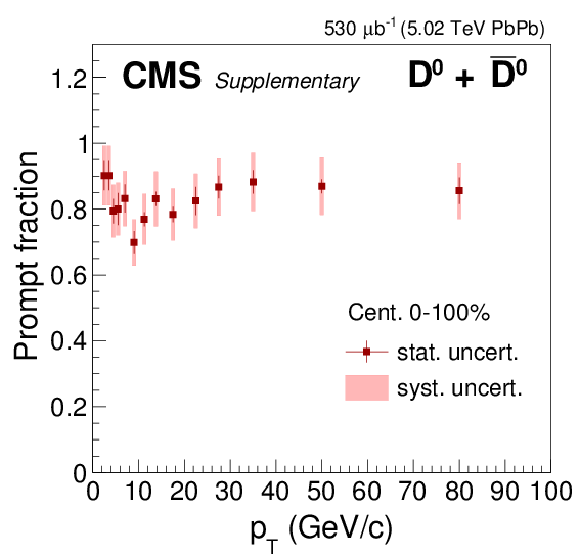
png pdf |
Additional Figure 2:
Fraction of $ {\mathrm {D}^{0}} $ mesons that come directly from c quark fragmentation as a function of $p_{\mathrm{T}}$ in the centrality range 0-100% in PbPb collisions at 5.02 TeV. |

png pdf |
Additional Figure 3:
Fraction of $ {\mathrm {D}^{0}} $ mesons that come directly from c quark fragmentation as a function of $p_{\mathrm{T}}$ in the centrality range 0-10% in PbPb collisions at 5.02 TeV. |

png pdf |
Additional Figure 4:
Example of DCA distribution of $ {\mathrm {D}^{0}} $ mesons (black marks) with templates of prompt (red histogram) and non-prompt (blue histogram) $ {\mathrm {D}^{0}} $ mesons from simulations in pp collisions at 5.02 TeV. |
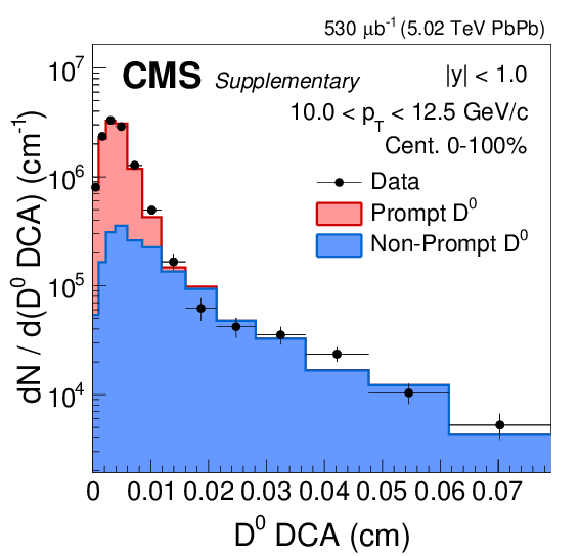
png pdf |
Additional Figure 5:
Example of DCA distribution of $ {\mathrm {D}^{0}} $ mesons (black marks) with templates of prompt (red histogram) and non-prompt (blue histogram) $ {\mathrm {D}^{0}} $ mesons from simulations in the centrality range 0-100% in PbPb collisions at 5.02 TeV. |

png pdf |
Additional Figure 6:
Example of DCA distribution of $ {\mathrm {D}^{0}} $ mesons (black marks) with templates of prompt (red histogram) and non-prompt (blue histogram) $ {\mathrm {D}^{0}} $ mesons from simulations in the centrality range 0-10% in PbPb collisions at 5.02 TeV. |

png pdf |
Additional Figure 7:
Nuclear modification factor $ {R_{\mathrm {AA}}} $ as a function of $ {p_{\mathrm {T}}} $ in the centrality range 0-100%. |

png pdf |
Additional Figure 8:
Nuclear modification factor $ {R_{\mathrm {AA}}} $ as a function of $ {p_{\mathrm {T}}} $ in the centrality range 0-10%. |

png pdf |
Additional Figure 9:
Nuclear modification factor $ {R_{\mathrm {AA}}} $ as a function of $ {p_{\mathrm {T}}} $ in the centrality range 0-100$%$ (green squares) compared to the $ {R_{\mathrm {AA}}} $ of charged particles (red circles) [21] and $ {\mathrm {B}^{\pm}} $ mesons (blue triangles) [48] at 5.02 TeV. |
| References | ||||
| 1 | E. V. Shuryak | Theory of hadron plasma | Sov. Phys. JETP 47 (1978)212 | |
| 2 | J. C. Collins and M. J. Perry | Superdense matter: Neutrons or asymptotically free quarks? | PRL 34 (1975) 1353 | |
| 3 | F. Karsch and E. Laermann | Thermodynamics and in-medium hadron properties from lattice QCD | in Quark-Gluon Plasma III, R. Hwa, ed 2003 | hep-lat/0305025 |
| 4 | F.-M. Liu and S.-X. Liu | Quark-gluon plasma formation time and direct photons from heavy ion collisions | PRC 89 (2014) 034906 | |
| 5 | Y. L. Dokshitzer and D. E. Kharzeev | Heavy quark colorimetry of QCD matter | PLB 519 (2001) 199 | hep-ph/0106202 |
| 6 | N. Armesto, C. A. Salgado, and U. A. Wiedemann | Medium induced gluon radiation off massive quarks fills the dead cone | PRD 69 (2004) 114003 | hep-ph/0312106 |
| 7 | A. Andronic et al. | Heavy-flavour and quarkonium production in the LHC era: from proton-proton to heavy-ion collisions | EPJC 76 (2016) 107 | 1506.03981 |
| 8 | M. L. Miller, K. Reygers, S. J. Sanders, and P. Steinberg | Glauber modeling in high energy nuclear collisions | Ann. Rev. Nucl. Part. Sci. 57 (2007) 205 | nucl-ex/0701025 |
| 9 | ALICE Collaboration | Centrality dependence of high-p$ _{T} $ D meson suppression in Pb-Pb collisions at $ \sqrt{{s}_{\mathrm{NN}}}= $ 2.76 TeV | JHEP 11 (2015) 205 | 1506.06604 |
| 10 | ALICE Collaboration | Transverse momentum dependence of D-meson production in Pb-Pb collisions at $ \sqrt{{s}_{\mathrm{NN}}}= $ 2.76 TeV | JHEP 03 (2016) 081 | 1509.06888 |
| 11 | ALICE Collaboration | Production of charged pions, kaons and protons at large transverse momenta in pp and PbPb collisions at $ \sqrt{{s}_{\mathrm{NN}}} = $ 2.76 TeV | PLB 736 (2014) 196 | 1401.1250 |
| 12 | ALICE Collaboration | Centrality dependence of charged particle production at $ \sqrt{{s}_{\mathrm{NN}}} = $ 2.76 TeV | PLB 720 (2013) 52 | 1208.2711 |
| 13 | STAR Collaboration | Observation of $ {D}^{0} $ meson nuclear modifications in $ \mathrm{Au}+\mathrm{Au} $ collisions at $ \sqrt{{s}_{\mathrm{NN}}}= $ 200 GeV | PRL 113 (2014) 142301 | 1404.6185 |
| 14 | CMS Collaboration | Suppression and azimuthal anisotropy of prompt and nonprompt $ \mathrm{J}/\psi $ production in PbPb collisions at $ \sqrt{{s}_{\mathrm{NN}}}= $ 2.76 TeV | EPJC 77 (2017) 252 | CMS-HIN-14-005 1610.00613 |
| 15 | K. J. Eskola, H. Paukkunen, and C. A. Salgado | EPS09 --- A new generation of NLO and LO nuclear parton distribution functions | JHEP 04 (2009) 065 | 0902.4154 |
| 16 | D. de Florian and R. Sassot | Nuclear parton distributions at next to leading order | PRD 69 (2004) 074028 | hep-ph/0311227 |
| 17 | L. Frankfurt, V. Guzey, and M. Strikman | Leading twist nuclear shadowing phenomena in hard processes with nuclei | PR 512 (2012) 255 | 1106.2091 |
| 18 | ALICE Collaboration | Measurement of prompt $ D $-meson production in $ p-Pb $ collisions at $ \sqrt{{s}_{\mathrm{NN}}} = $ 5.02 TeV | PRL 113 (2014) 232301 | 1405.3452 |
| 19 | CMS Collaboration | Study of B meson production in p+Pb collisions at $ \sqrt{{s}_{\mathrm{NN}}}= $ 5.02 TeV using exclusive hadronic decays | PRL 116 (2016) 032301 | CMS-HIN-14-004 1508.06678 |
| 20 | CMS Collaboration | The CMS experiment at the CERN LHC | JINST 3 (2008) S08004 | CMS-00-001 |
| 21 | CMS Collaboration | Charged-particle nuclear modification factors in PbPb and pPb collisions at $ \sqrt{{s}_{\mathrm{NN}}} = $ 5.02 TeV | JHEP 04 (2017) 039 | CMS-HIN-15-015 1611.01664 |
| 22 | CMS Collaboration | Transverse momentum and pseudorapidity distributions of charged hadrons in pp collisions at $ \sqrt{s} = $ 0.9 and 2.36 TeV | JHEP 02 (2010) 041 | CMS-QCD-09-010 1002.0621 |
| 23 | T. Sjostrand et al. | An Introduction to PYTHIA 8.2 | CPC 191 (2015) 159 | 1410.3012 |
| 24 | CMS Collaboration | Event generator tunes obtained from underlying event and multiparton scattering measurements | EPJC 76 (2016) 155 | CMS-GEN-14-001 1512.00815 |
| 25 | GEANT4 Collaboration | GEANT4 --- a simulation toolkit | NIMA 506 (2003) 250 | |
| 26 | D. J. Lange | The EvtGen particle decay simulation package | NIMA 462 (2001) 152 | |
| 27 | E. Barberio, B. van Eijk, and Z. Was | Photos -- a universal Monte Carlo for QED radiative corrections in decays | CPC 66 (1991) 115 | |
| 28 | I. P. Lokhtin and A. M. Snigirev | A model of jet quenching in ultrarelativistic heavy ion collisions and high-$ {p_{\mathrm{T}}} $ hadron spectra at RHIC | EPJC 45 (2006) 211 | hep-ph/0506189 |
| 29 | Particle Data Group, C. Patrignani et al. | Review of Particle Physics | CPC 40 (2016), no. 10, 100001 | |
| 30 | H. Voss, A. Hocker, J. Stelzer, and F. Tegenfeldt | TMVA, the toolkit for multivariate data analysis with ROOT | in XIth International Workshop on Advanced Computing and Analysis Techniques in Physics Research (ACAT), p. 40 2007 | physics/0703039 |
| 31 | CMS Collaboration | Measurement of tracking efficiency | CMS-PAS-TRK-10-002 | |
| 32 | M. Cacciari, M. Greco, and P. Nason | The $ {p_{\mathrm{T}}} $ spectrum in heavy flavor hadroproduction | JHEP 05 (1998) 007 | hep-ph/9803400 |
| 33 | CMS Collaboration | CMS luminosity calibration for the $ pp $ reference run at $ \sqrt{s} = $ 5.02 TeV | CMS-PAS-LUM-16-001 | CMS-PAS-LUM-16-001 |
| 34 | B. A. Kniehl, G. Kramer, I. Schienbein, and H. Spiesberger | Inclusive $ D^{*\pm} $ production in $ p\bar{p} $ collisions with massive charm quarks | PRD 71 (2005) 014018 | hep-ph/0410289 |
| 35 | B. A. Kniehl, G. Kramer, I. Schienbein, and H. Spiesberger | Collinear subtractions in hadroproduction of heavy quarks | EPJC 41 (2005) 199 | hep-ph/0502194 |
| 36 | B. A. Kniehl, G. Kramer, I. Schienbein, and H. Spiesberger | Inclusive charmed-meson production at the CERN LHC | EPJC 72 (2012) 2082 | 1202.0439 |
| 37 | M. Djordjevic and M. Djordjevic | Predictions of heavy-flavor suppression at 5.1 TeV Pb+Pb collisions at the CERN Large Hadron Collider | PRC 92 (2015) 024918 | 1505.04316 |
| 38 | J. Xu, J. Liao, and M. Gyulassy | Bridging soft-hard transport properties of quark-gluon plasmas with CUJET3.0 | JHEP 02 (2016) 169 | 1508.00552 |
| 39 | J. Xu, A. Buzzatti, and M. Gyulassy | Azimuthal jet flavor tomography with CUJET2.0 of nuclear collisions at RHIC and LHC | JHEP 08 (2014) 063 | 1402.2956 |
| 40 | J. Xu, J. Liao, and M. Gyulassy | Consistency of perfect fluidity and jet quenching in semi-quark-gluon monopole plasmas | Chin. PL32 (2015) 092501 | 1411.3673 |
| 41 | Z.-B. Kang et al. | Jet quenching phenomenology from soft-collinear effective theory with Glauber gluons | PRL 114 (2015) 092002 | 1405.2612 |
| 42 | Y.-T. Chien et al. | Jet quenching from QCD evolution | PRD 93 (2016) 074030 | 1509.02936 |
| 43 | S. Cao, T. Luo, G.-Y. Qin, and X.-N. Wang | Linearized Boltzmann transport model for jet propagation in the quark-gluon plasma: Heavy quark evolution | PRC 94 (2016) 014909 | 1605.06447 |
| 44 | S. Cao, T. Luo, G.-Y. Qin, and X.-N. Wang | Heavy and light flavor jet quenching at RHIC and LHC energies | 1703.00822 | |
| 45 | T. Song et al. | Tomography of the quark-gluon-plasma by charm quarks | PRC 92 (2015) 014910 | 1503.03039 |
| 46 | T. Song et al. | Charm production in Pb + Pb collisions at energies available at the CERN Large Hadron Collider | PRC 93 (2016) 034906 | 1512.00891 |
| 47 | W. A. Horowitz | Fluctuating heavy quark energy loss in a strongly coupled quark-gluon plasma | PRD 91 (2015) 085019 | 1501.04693 |
| 48 | CMS Collaboration | Measurement of the B$ ^{+/-} $ meson nuclear modification factor in Pb-Pb collisions at $ \sqrt{{s}_{NN}} = $ 5.02 TeV | PRL 119 (Oct, 2017) 152301 | CMS-HIN-16-011 1705.04727 |
| 49 | CMS Collaboration | Measurement of prompt and nonprompt charmonium suppression in PbPb collisions at 5.02 TeV | Submitted to EPJC | CMS-HIN-16-025 1712.08959 |

|
Compact Muon Solenoid LHC, CERN |

|

|

|

|

|

|